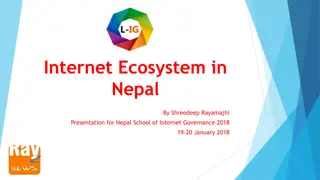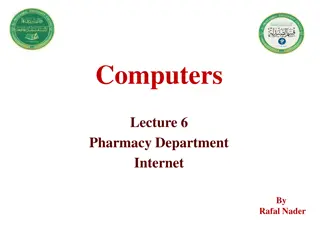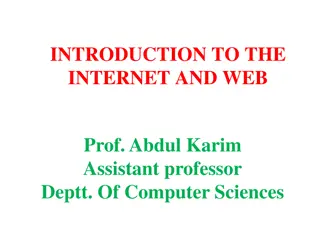Understanding Internet Tools and Terminology
The Internet is a global network of interconnected computers utilizing the TCP/IP communication method. It includes the World Wide Web, browsers for accessing content, servers for data transfer, websites with webpages displayed via web servers, URLs for addressing resources, and protocols like SMTP, FTP, HTTP, TCP/IP, and ISP services for internet access. This overview covers key concepts and terminology essential for navigating the digital landscape.
Download Presentation

Please find below an Image/Link to download the presentation.
The content on the website is provided AS IS for your information and personal use only. It may not be sold, licensed, or shared on other websites without obtaining consent from the author. Download presentation by click this link. If you encounter any issues during the download, it is possible that the publisher has removed the file from their server.
E N D
Presentation Transcript
Tools and Terminology Used for Internet
What is Internet. The Internet is a world wide network of computers that are connected (networked) and are using the communication method called TCP/IP. World Wide Web Also called web or www, it is a collection of information, resources, pictures, sounds, multimedia on the internet that are linked and connected together. Browser. A browser is a software application used to locate, retrieve and display content on the World Wide Web, including webpages, images, video and other files. Host. A computer that is used to transfer data on the Internet. Server. A server is a computer that provides data to other computers. It may serve data to systems on a local area network (LAN) or a wide area network (WAN) over the Internet.
Website. A website (also written as web site) is a collection of web pages and related content that is identified by a common domain name and published on at least one web server. wikipedia.org, google.com, and amazon.com. Webpage. A document which can be displayed in a web browser. Web Server. A computer that hosts a website on the Internet. Home Page. A home Page is the main or index page of a web site. HTML. HTML stands for Hypertext Markup Language. It allows the user to create and structure sections, paragraphs, headings, links, and block quotes for web pages and applications.
URL Uniform Resource Locator is a web address used to connect to a remote resource on the world wide web. For example: https://www.comentum.com ftp://ftp.comentum.com telnet://info.comentum.com Addressing There are two type of addressing DNS Addressing. DNS (Domain Name System) is a large database of domain names and their correspondent Internet (IP Addresses) for example: www.widget.com corrisponds to it's unique number 207.168.6.12. there are different domain like .edu, .gov, .com. IP Addressing. An IP (Internet Protocol) address is an unique number used to identify a computer on the Internet. If you are connected to the Internet, you must have a unique network number, which is an IP address. 207.168.6.12 There are four numbers separated by a dot, and are between 0 and 255. An example of an IP address is:
Internet Protocol SMTP SMTP is simple mail transfer protocol, used to transfer e-mail over the internet. FTP FTP is file transfer protocol, used to transfer files over the internet. HTTP HTTP means Hyper Text Transfer Protocol. HTTP is the underlying protocol used by the World Wide Web and this protocol defines how messages are formatted and transmitted. TCP/IP Transmission Control Protocol, used to transfer data over the internet. NNTP The Network News Transfer Protocol (NNTP) is an for transporting Usenet news articles (netnews) between news servers and for reading and posting articles by end user client applications. application protocol used
ISP An Internet service provider (ISP) is a company that provides customers with Internet access. Data may be transmitted using several technologies, including dial-up, DSL, cable modem, wireless or dedicated high-speed interconnects.























